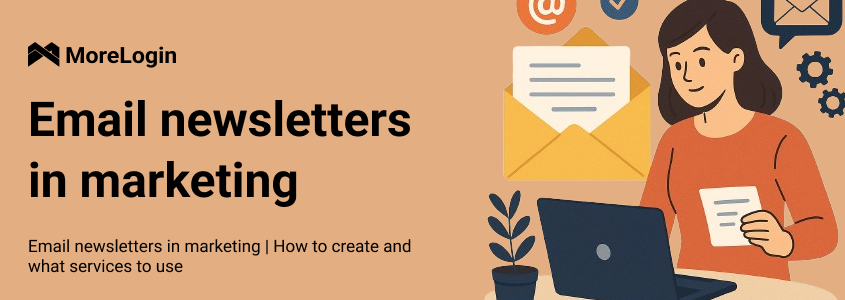
- Product

- Pricing
- Affiliate Program
- Use Cases
- Resource


Email marketing remains one of the most cost-effective tools in digital promotion. When properly set up, newsletters can boost sales, increase engagement, retain customers, and strengthen your brand. Below is a step-by-step guide to creating email campaigns—from goals and email types to email services and spam protection.
Before launching a campaign, you need to define its goal. This could be:
Sent immediately after a user registers or subscribes, a welcome email introduces your brand and product. It should engage new users, highlight key benefits, and include a CTA encouraging the first step—like completing a profile or logging into an account.
Automatically sent to users who added products to their cart but didn’t complete the purchase. This email reminds them of the forgotten items and offers motivation—such as a time-limited discount, free shipping, or bonus—to encourage conversion.
Sent after a successful purchase, this email confirms the transaction and thanks the customer. It often includes upselling or cross-selling suggestions to increase the order value.
Sent 3–7 days post-purchase, this email asks the customer to leave a review. It helps collect feedback, improve the product, and shows that the customer's opinion matters. It also enhances brand reputation and customer loyalty.
Targeted at inactive users, this type of email aims to rekindle interest in your brand. It usually includes personalized offers, discounts, or useful content to reactivate engagement.
Placed on your website, these forms collect user contacts. To be effective, they should clearly state the value of subscribing—such as access to exclusive content, discounts, or bonuses. Copy must be clear and benefit-focused.
These forms can be highly effective when displayed with the right timing—like on exit intent, after a certain time spent on the page, or on scroll. The offer must be genuinely valuable, and the pop-ups should not be intrusive.
Website chat tools can also help collect email addresses. During a helpful conversation, you can subtly ask for an email to follow up, share tailored offers, or maintain chat history.
⚠️ Never use purchased or unsolicited email lists. Doing so damages sender reputation, can trigger spam filters, and violates data protection laws, possibly resulting in fines or legal issues. Always ensure your list is opt-in and provide easy unsubscribe options.

To avoid landing in spam folders, follow both technical and content guidelines:
Use neutral language in your email content. Avoid trigger words like “FREE,” “URGENT,” “100,000₽,” excessive capital letters, or exclamation marks.
Specify a recognizable sender name and brand. This builds trust and reduces spam complaints.
Keep HTML email size under 100KB to ensure proper loading and deliverability.
Use clean and optimized code and compress images properly.
Avoid URL shorteners and shady links. Use branded domains with SSL certificates and good reputations.
A robust platform with automation, analytics, templates, and integrations (CRM, CMS, etc.). Ideal for medium to large businesses, especially in English-speaking markets.
A simple and affordable Russian-language tool supporting both email and SMS. It offers basic automation, templates, and segmentation—perfect for small businesses and beginners.
An all-in-one platform that combines email, SMS, push notifications, chatbots, and personalization. It supports automation workflows, A/B testing, and has a free plan—ideal for omnichannel marketing.
A multi-account browser with anti-detection features. Helps manage several email platforms safely, avoiding blocks due to identical digital fingerprints. Suitable for agencies and teams handling multiple projects.
Email marketing works best when it’s part of a systematic strategy—segmented audiences, clean design, verified content, and regular analytics. Apply the techniques and tools above to turn your email channel into a reliable engine of growth and loyalty.